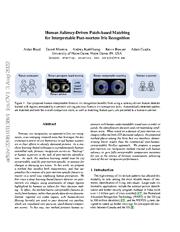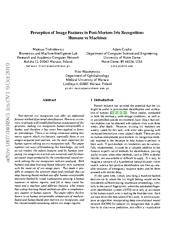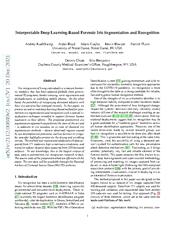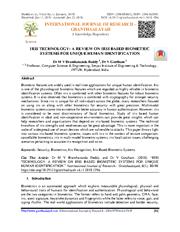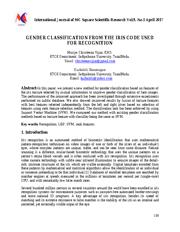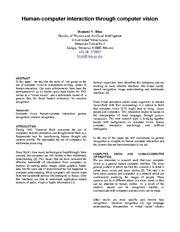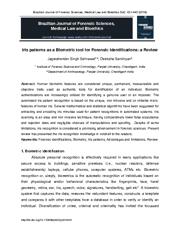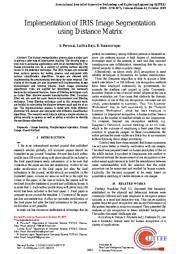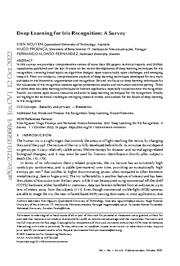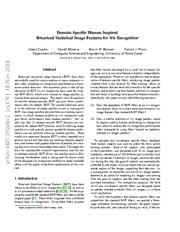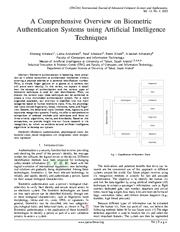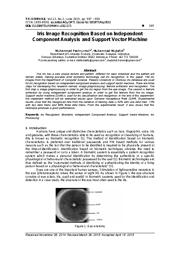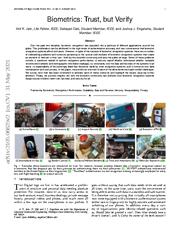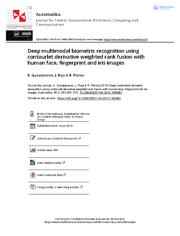A copy of this work was available on the public web and has been preserved in the Wayback Machine. The capture dates from 2022; you can also visit the original URL.
The file type is application/pdf.
Filters
Human Saliency-Driven Patch-based Matching for Interpretable Post-mortem Iris Recognition
[article]
2022
arXiv
pre-print
We first train a deep learning-based feature detector on post-mortem iris images, using annotations of image regions highlighted by humans as salient for their decision making. ...
In effect, the method learns interpretable features directly from humans, rather than purely data-driven features. ...
live human-interpretable iris recognition. ...
arXiv:2208.03138v1
fatcat:idq4mos5j5f47co6tttz24rrpi
Perception of Image Features in Post-Mortem Iris Recognition: Humans vs Machines
[article]
2019
arXiv
pre-print
This paper offers the first known to us human-interpretable comparison of machine-based and human-based post-mortem iris recognition, and the trained models annotating salient iris image regions. ...
This paper explores two ways of broadening this knowledge: (a) with an eye tracker, the salient features used by humans comparing iris images on a screen are extracted, and (b) class-activation maps produced ...
There are also no human-interpretable post-mortem iris recognition methods reported in the literature to help human examiners in their work. ...
arXiv:1807.04049v3
fatcat:yr6rojo3ojhwvnhxhyqntvxwvm
Interpretable Deep Learning-Based Forensic Iris Segmentation and Recognition
[article]
2021
arXiv
pre-print
In this paper, we present an end-to-end deep learning-based method for postmortem iris segmentation and recognition with a special visualization technique intended to support forensic human examiners in ...
On the other hand, the possibility of recognizing deceased subjects with their iris patterns has emerged recently. ...
Interpretable Deep Learning-Based Forensic Iris Segmentation and Recognition
Andrey Kuehlkamp Aidan Boyd ...
arXiv:2112.00849v2
fatcat:35uvyz2gzncwnbdnw6ch7uzriy
IRIS TECHNOLOGY: A REVIEW ON IRIS BASED BIOMETRIC SYSTEMS FOR UNIQUE HUMAN IDENTIFICATION
2018
International journal of research - granthaalayah
issues, challenging scenarios pertaining to accurate iris recognition and so on. ...
Study of iris based human identification in ideal and non-cooperative environments can provide great insights which can help researchers and organizations that depend on iris-based biometric systems. ...
However, it is found that iris localization in influenced by texture. When it is not interpreted properly, commercial iris-based biometric systems provide inaccurate results while identifying humans. ...
doi:10.29121/granthaalayah.v6.i1.2018.1596
fatcat:nnnyzbawqrhoje5iji362nb2eq
Gender Classification From The Iris Code Used For Recognition
2017
International Journal of MC Square Scientific Research
We also showed improved results by fusion of texture features with best features selected independently from the left and right irises based on selection of features using rank feature selection method ...
In this paper, we present a new method for gender classification based on features of the iris texture selected by mutual information to improve gender classification of face images. ...
Introduction Iris recognition is an automated method of biometric identification that uses mathematical pattern-recognition techniques on video images of one or both of the irises of an individual's eyes ...
doi:10.20894/ijmsr.117.009.001.027
fatcat:7ja6323dfffprjuvw6jsek3s6q
Human-computer interaction through computer vision
2001
CHI '01 extended abstracts on Human factors in computer systems - CHI '01
In this paper, we describe the work of our group on the use of computer vision to complement existing modes of human-interaction. ...
recognition. ...
This interaction would be based on the interpretation of body language, through gesture recognition. ...
doi:10.1145/634099.634106
fatcat:h34m3anv3jh5bkqpyvzbclo2qe
Human-computer interaction through computer vision
2001
CHI '01 extended abstracts on Human factors in computing systems - CHI '01
In this paper, we describe the work of our group on the use of computer vision to complement existing modes of human-interaction. ...
recognition. ...
This interaction would be based on the interpretation of body language, through gesture recognition. ...
doi:10.1145/634067.634106
dblp:conf/chi/Rios-Figueroa01
fatcat:xkfw2wwqg5c5phnkq3tehgdgm4
Iris Patterns As A Biometric Tool For Forensic Identifications: A Review
2016
Brazilian Journal of Forensic Sciences, Medical Law and Bioethics
The automated iris pattern recognition is based on the unique, non-intrusive and un-imitable microfeatures of human iris. ...
Biometric recognition or, simply, biometrics is the automatic recognition of individuals based on their physiological and/or behavioral characteristics like fingerprints, face, hand geometry, retina, ear ...
To make iris recognition a human-friendly technique (especially for forensic purposes), the similarities between irises should be made visualizable, interpretable and explainable 28 . ...
doi:10.17063/bjfs5(4)y2016431
fatcat:i6xd7lnuxvcj3bkspplbo5edpu
Implementation of IRIS Image Segmentation using Distance Matrix
2019
VOLUME-8 ISSUE-10, AUGUST 2019, REGULAR ISSUE
Basic image processing algorithmic rules are applied for identifying the necessary features for enhanced features. ...
The human reorganization process plays a major part in giving a safer way of information sharing. The security plays a vital role in accessing applications with lot of confidentiality. ...
Geetanjali Sharma and Neerav Mehan [10] [21] explained that biometric features based system provided an automated recognition for a person based on unique features of an individual. ...
doi:10.35940/ijitee.l3359.1081219
fatcat:xv6kwvsr45btxj4bqzwmvtexui
Deep Learning for Iris Recognition: A Survey
[article]
2022
arXiv
pre-print
Second, we focus on deep learning techniques for the robustness of iris recognition systems against presentation attacks and via human-machine pairing. ...
for iris recognition, covering broad topics on algorithm designs, open-source tools, open challenges, and emerging research. ...
[91] argued that existing iris recognition methods offer limited and non-standard methods of visualization to let human examiners interpret the model output. ...
arXiv:2210.05866v1
fatcat:7xhng57jhrdibi6vuvb2pqxdni
Domain-Specific Human-Inspired Binarized Statistical Image Features for Iris Recognition
[article]
2018
arXiv
pre-print
One important point is that all applications of BSIF in iris recognition have used the original BSIF filters, which were trained on image patches extracted from natural images. ...
Can image patches derived from eye-tracking experiments, in which humans perform an iris recognition task, give better performance than random patches? ...
In contrast to texture description, some researchers have lately tried to describe alternative iris features, including salient interest points [1, 2] and human-interpretable features [5] . ...
arXiv:1807.05248v2
fatcat:gjvgsadlqrhtdk3chqhdzo5q2a
A Comprehensive Overview on Biometric Authentication Systems using Artificial Intelligence Techniques
2022
International Journal of Advanced Computer Science and Applications
For a more organized approach, our overview is classified into two main categories based on human biometric traits. ...
Based on this comparison, we provide insight into our future research in iris recognition, by which we combine several artificial intelligence algorithms to develop our system. ...
An iris recognition system is a type of biometric system that uses images of human irises to identify people. It features two main processes: localization and segmentation. ...
doi:10.14569/ijacsa.2022.0130491
fatcat:yncba2tkpjcddm2nx6pgy4lrdm
Iris Image Recognition Based on Independent Component Analysis and Support Vector Machine
2015
TELKOMNIKA (Telecommunication Computing Electronics and Control)
In this paper, 150 iris images from the Department of Computer Science, Palacky University in Olomouc iris database are used for iris recognition based on independent component analysis and support vector ...
The second is feature extraction by using independent component analysis in order to get the feature from the iris image. Support vector machine (SVM) is used for iris classification and recognition. ...
on iris recognition. ...
doi:10.12928/telkomnika.v13i2.1171
fatcat:ni4b6bailfazvkhgxa7mx6pux4
Biometrics: Trust, but Verify
[article]
2021
arXiv
pre-print
However, in-spite of the success of biometric recognition systems, there are a number of outstanding problems and concerns pertaining to the various sub-modules of biometric recognition systems that create ...
Over the past two decades, biometric recognition has exploded into a plethora of different applications around the globe. ...
The representation could be based on handcrafted features (e.g., fingerprint minutiae or iris hamming codes), learned features (e.g., deep face representations), or a combination of handcrafted features ...
arXiv:2105.06625v2
fatcat:gnii3qxufzevzlkfimhmmwof7i
Deep multimodal biometric recognition using contourlet derivative weighted rank fusion with human face, fingerprint and iris images
2019
Automatika
This paper explains a deep multimodal biometric system for human recognition using three traits, face, fingerprint and iris. ...
pre-processed multimodality features, therefore improving recognition accuracy. ...
Furthermore based on the Log Likelihood Ratio, matching between the training and test set was conducted based on the mutual information values (i.e. face, fingerprint and iris), that in turn improved the ...
doi:10.1080/00051144.2019.1565681
fatcat:ziqkw7iw6veabakdsoo5j7vh3i
« Previous
Showing results 1 — 15 out of 18,852 results

